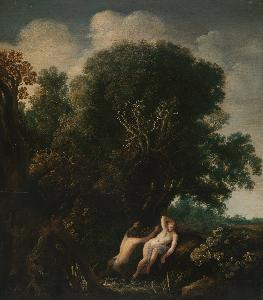Moses Van Uyttenbroeck
Moses Van Uyttenbroeck;Moyses Van Wtenbrouck
Place: The Hague
Death: 1646
Biography:
Moses Van Uyttenbroeck, also known as Moyses van Wtenbrouck, was a Dutch Golden Age painter and etcher born in The Hague, Netherlands around 1600. He was a prominent figure in the Dutch art scene during the 17th century, known for his Arcadian landscapes and mythological themes. Van Uyttenbroeck's work is characterized by its unique blend of Italian and Northern European influences, reflecting the cultural exchange that occurred during this period.
Early Life and Career
Van Uyttenbroeck joined the Guild of Saint Luke in 1614, an organization that played a significant role in the development of Dutch art. He was influenced by the works of Adam Elsheimer and other Italianizing landscape painters, such as Cornelis van Poelenburch. Van Uyttenbroeck's paintings often featured bacchanalia with music, dancing, and erotic undercurrents, showcasing his fascination with classical mythology.
Artistic Style and Themes
Van Uyttenbroeck's artistic style is marked by its use of rich colors and dramatic lighting. His paintings often depicted scenes from the Old Testament and classical mythology, with a focus on the Metamorphoses of Ovid. The National Gallery, London and the Mauritshuis in The Hague house some of his notable works, including A Bathing Nymph Taken by Surprise by a Satyr. This painting showcases Van Uyttenbroeck's ability to blend mythological themes with landscapes, creating a unique and captivating visual experience.
Influence and Legacy
Van Uyttenbroeck's work had a significant impact on the Dutch art scene during the 17th century. His use of Italianate landscapes and mythological themes influenced other artists, such as Willem Frederik Van Royen. The painting by Moses Van Uyttenbroeck is a notable example of his style and influence. For more information on Van Uyttenbroeck's life and work, visit Wikioo.org or Wikipedia.
- Moses Van Uyttenbroeck was a prominent Dutch Golden Age painter and etcher.
- He was born in The Hague, Netherlands around 1600.
- Van Uyttenbroeck's work is characterized by its unique blend of Italian and Northern European influences.
- His paintings often featured bacchanalia with music, dancing, and erotic undercurrents.
- The National Gallery, London and the Mauritshuis house some of his notable works.
- A Bathing Nymph Taken by Surprise by a Satyr
- Peasants and Cattle by the River Merwede
- Self-Portrait with Wide-Open Eyes
- The National Gallery, London
- Mauritshuis
- Museum Huis ten Bosch

